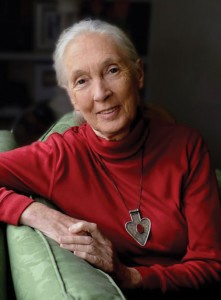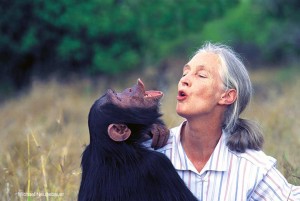Jane Goodall at the Osa Field Institute: The Woman Who Redefined Man

By Evelyn Gallardo
Kudos go to the Osa Field Institute (OFI) for its standing room only grand opening in Uvita and for bringing Dr. Jane Goodall in as its keynote speaker.
Executive Director, Dr. Julie Reyes, made a brief opening statement under a rancho setting about OFI being established as a field school where students, faculty, tourists and life long learners could team up to experience Costa Rica and conduct research together in the heart of a primary rain forest. She then introduced her hero, Dr. Jane Goodall, who was greeted with a standing ovation. She stood on a step stool throughout her talk explaining that she wanted to see each of the 200 attendees.
Dr. Goodall is not only one of the most famous scientists in the world; she’s a good storyteller. She began by sharing her first scientific observation at 4½ years old when she covered herself with straw and hid in the family’s hen house to discover how hens lay their eggs without any visible means of accomplishing such a feat.
The crowd laughed when she talked about her early love of Tarzan books and her disappointment when he married the “wrong” Jane.
She revealed her insecurities when mentor, Dr. Louis Leakey, told her to skip getting a B.A. or M.A. and to go directly for her Ph.D. She’s one of few ever admitted to the Cambridge Ph.D. program without a college degree. She was right to worry that her professors might begrudge the special treatment given to a girl whose previous experience was as a secretary and a waitress. They told her she was conducting her research wrong. She was supposed to give chimps numbers not names. She was accused of anthropomorphizing her subjects by attributing them with human emotions.

However, Dr. Goodall’s lack of formal training instead became her greatest asset. It allowed her to conduct her research without bias – exactly what Leakey had hoped for.
She had six months to prove herself before her funds ran out. One day she observed a chimp named David Greybeard strip leaves from a twig then poke it into a termite mound. He then slipped his “fishing pole” between his lips and ate the cashew-flavored termites clinging to it. This was the moment that made everything possible.
“Now we must redefine tool, redefine man, or accept chimpanzees as humans,” Leakey declared after hearing about his protégée’s astonishing discovery.
During her years at what was then known as Gombe Stream Chimpanzee Reserve in Tanganyika (now Tanzania), Dr. Goodall’s daily observations continued to peel away the veiled layers of chimp social structure and behavior. They were thinking, intelligent beings with complex emotions ranging from anger to joy, from humor to depression and a host of other feelings previously attributed only to humans.
She wrote about long-term chimpanzee family relationships including the bond between mothers and their offspring. She discovered that good mothers bred good mothers. Matriarch Flo doted on her offspring. Her daughters, Fifi and Flame went on to be doting mothers themselves. Flo became so famous that when she died in 1972, the London Times published her obituary.
DNA studies would later reveal a scant 1% difference between the DNA of chimps and humans. If Dr. Goodall had known this at the time she wouldn’t have been so shocked when her research exposed a dark side to chimps. “They have territorial wars that sometimes can lead to death. They’ll team up with other males to overthrow a group leader,” she said.
She went on to talk about her worldwide program for children, Roots and Shoots that teaches kids to care about the environment and to contribute to improving the world. Children from the local Roots and Shoots delivered a heartfelt birthday (April 3) message to Dr. Goodall promising to do their part to help the planet.
The woman who redefined man closed by talking about the threats to chimpanzees, environmental issues, and her reasons for hope that humans can find solutions to the dilemmas they have inflicted on the earth.
“It gives me hope to come to places like this,” Dr. Goodall said.
It’s inconceivable to overstate just how much Dr. Goodall has impacted the field of primatology. She challenged scientific convention by giving Gombe chimps names instead of numbers then she insisted on the soundness of her observations that animals have unique personalities, minds and emotions. She pioneered long-term primate field research, a field that is now dominated by women such Biruté Galdikas, Francine Patterson and Sue Savage-Rumbaugh.
Dr. Goodall travels 300 days a year delivering her message of hope. As she stepped down from her makeshift podium, the crowd rose to give her another standing ovation. There was hope in the air.
Osa Field Institute www.osafieldinstitute.org
Jane Goodall Institute www.janegoodall.org
Evelyn Gallardo is a local nonfiction writer whose books include “Among the Orangutans – The Biruté Galdikas Story.” She and her husband, David Root, worked as volunteers on Dr. Galdikas’ Orangutan Project in Borneo in 1984/1987 and with Dr. Dian Fossey’s mountain gorilla research in Rwanda in 1985. Evelyn’s photos appear in Jane Goodall’s book, Animal World: Mountain Gorillas.
